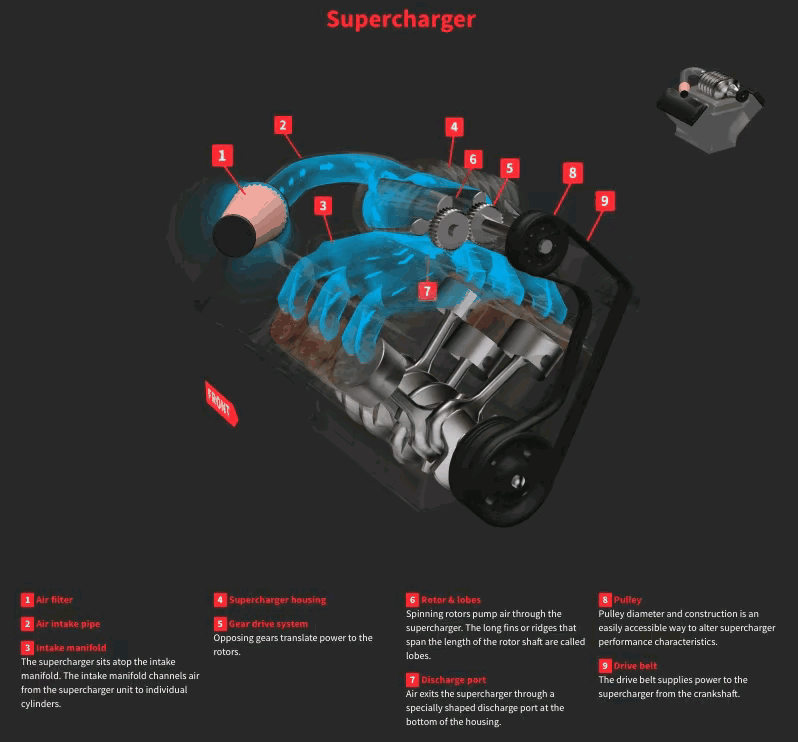What is a Supercharger?
A supercharger might sound like a superhero's name, but it’s actually a device that boosts your car’s “lung capacity”! In simple terms, a supercharger is an “air compressor” that pumps more air into the engine, allowing the car to take in more “oxygen” and thus produce more power. It’s like giving your car an oxygen boost, helping it go faster and feel more powerful!
How Does a Supercharger Work?
Looking at this diagram (pointing to the image), a supercharger is made up of the following key parts:
- Air Filter: Filters out impurities in the air to prevent dust from entering the engine.
- Air Intake Pipe: Directs air into the supercharger.
- Intake Manifold: Distributes the compressed air to each cylinder.
- Supercharger Housing: The outer shell of the supercharger, protecting internal parts.
- Gear Drive System: Uses gears to transfer power to the rotors.
- Rotor & Lobes: Rotates at high speed to “compress” and deliver air to the engine.
- Discharge Port: Sends the air through to the intake manifold.
- Pulley: Allows for fine-tuning of the supercharger’s boost by adjusting the pulley diameter.
- Drive Belt: Transfers power from the crankshaft to the supercharger.
When you press the accelerator, the drive belt spins the rotors at high speed, compressing the air and sending it into the engine, which makes combustion more efficient and produces more power! It’s like giving your muscles a shot of adrenaline!
What Types of Cars Need a Supercharger?
Superchargers are usually installed on high-performance vehicles, like sports cars and certain performance models, such as the Mustang or Corvette. Some heavy-duty trucks might also use superchargers because they need extra power to handle heavy loads.
Common Supercharger Issues
- Belt Wear: Superchargers rely on belt drive, which can wear out or break over time.
- Air Leaks: If the supercharger’s pipes or seals have cracks, air will leak, reducing the boost.
- Gear or Rotor Damage: The rotor and gear are crucial components, and if they get damaged, the boost effect will drop significantly.
- Increased Noise: If you hear unusual noises from the supercharger, it could be due to worn or poorly lubricated internal parts.
How to Diagnose Supercharger Problems
If you suspect an issue with your supercharger, here are a few ways to check:
- Listen for Sounds: A functioning supercharger should operate smoothly and consistently. Any strange noises, like grinding or knocking, may mean there’s an issue with the belt or gears.
- Check Power Output: If your car feels sluggish on acceleration, it could be due to air flow issues or leaks in the supercharger.
- Inspect the Belt: Look for signs of wear or cracks on the belt and check if it’s loose.
- Check for Oil Leaks: Some superchargers require lubrication, so any leaks might mean a damaged seal.
Solutions and Maintenance
- Belt Replacement: Regularly inspect the belt, and if there’s visible wear or cracks, replace it in time.
- Seal the Pipes: Check the intake pipes of the supercharger regularly for cracks and make sure the seals are intact.
- Lubrication: Some superchargers require periodic lubrication to reduce component wear.
- Clean the Air Filter: The air filter should be replaced or cleaned regularly to ensure clean air intake.
- Professional Inspection: If you’re not familiar with superchargers, it’s best to have a professional check it regularly to prevent small issues from turning into big problems.
In Summary
A supercharger acts like a “powerful lung” for your car, helping the engine inhale more air and produce extra power. For most car owners, it’s a good idea to let professionals handle supercharger maintenance, but keeping an eye on belt wear, pipe seals, and lubrication can extend the life of your supercharger and keep your “ride” packed with power!
Superchargers don’t seem so mysterious now, do they? Hope this guide helps you understand the “little secrets” inside your car better!




